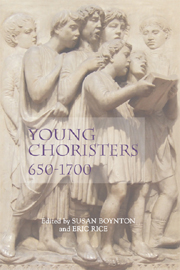Book contents
- Frontmatter
- Contents
- List of Illustrations
- List of Musical Examples
- Acknowledgements
- Dedication
- Introduction: Performance and Premodern Childhood
- 1 The Boy Singers of the Roman Schola Cantorum
- 2 Boy Singers in Medieval Monasteries and Cathedrals
- 3 The Musical Education of Young Girls in Medieval English Nunneries
- 4 Choirboys in Early English Religious Drama
- 5 From Mozos de coro towards Seises: Boys in the Musical Life of Seville Cathedral in the Fifteenth and Sixteenth Centuries
- 6 The Seeds of Medieval Music: Choirboys and Musical Training in a Late-Medieval Maîtrise
- 7 Choirboys in Cambrai in the Fifteenth Century
- 8 Choirboys and Vicaires at the Maîtrise of Cambrai: A Socio-anthropological Study (1550–1670)
- 9 Choirboys, Memorial Endowments and Education at Aachen's Marienkirche
- 10 Thomas Mulliner: An Apprentice of John Heywood?
- 11 Cantando tutte insieme: Training Girl Singers in Early Modern Sienese Convents
- 12 Choirboys in Early Modern Rome
- General Bibliography
- Index
2 - Boy Singers in Medieval Monasteries and Cathedrals
Published online by Cambridge University Press: 12 September 2012
- Frontmatter
- Contents
- List of Illustrations
- List of Musical Examples
- Acknowledgements
- Dedication
- Introduction: Performance and Premodern Childhood
- 1 The Boy Singers of the Roman Schola Cantorum
- 2 Boy Singers in Medieval Monasteries and Cathedrals
- 3 The Musical Education of Young Girls in Medieval English Nunneries
- 4 Choirboys in Early English Religious Drama
- 5 From Mozos de coro towards Seises: Boys in the Musical Life of Seville Cathedral in the Fifteenth and Sixteenth Centuries
- 6 The Seeds of Medieval Music: Choirboys and Musical Training in a Late-Medieval Maîtrise
- 7 Choirboys in Cambrai in the Fifteenth Century
- 8 Choirboys and Vicaires at the Maîtrise of Cambrai: A Socio-anthropological Study (1550–1670)
- 9 Choirboys, Memorial Endowments and Education at Aachen's Marienkirche
- 10 Thomas Mulliner: An Apprentice of John Heywood?
- 11 Cantando tutte insieme: Training Girl Singers in Early Modern Sienese Convents
- 12 Choirboys in Early Modern Rome
- General Bibliography
- Index
Summary
YOUNG boys were present in monastic communities in Western Europe by the early Middle Ages. The sixth-century Rule of Benedict refers to the practice of child oblation (the parents' offering of a child as a donation to a monastery), which was the most common form of entry into the religious life until around 1200. Oblates continued to form an important part of such populations through the twelfth century, but a decline in oblation accompanied the emergence of new religious orders (such as the Cistercians) who accepted only adult vocations. Benedictine monasteries continued to accept boys, although in diminishing numbers and at an increasing age. in the 1230s, Pope gregory IX set the minimum age for entry into a monastery at eighteen. The practice of oblation for girls lasted longer, through the early modern period.
As members of monastic communities, child singers took part in the performance of the office and Mass. Some of the earliest vestiges of their role in monastic musical performance come from the Carolingian period, when monasteries took on an increasingly important role as centers of ritual commemoration, while educating growing numbers of young boys. The presence of child oblates in this period is mentioned in prescriptive texts and in some cases is evident in the physical environment, as in the ninth-century abbey church of Corvey, where some graffiti in the western gallery of the upper level of the westwork have been interpreted as musical notation.
- Type
- Chapter
- Information
- Young Choristers, 650–1700 , pp. 37 - 48Publisher: Boydell & BrewerPrint publication year: 2008

